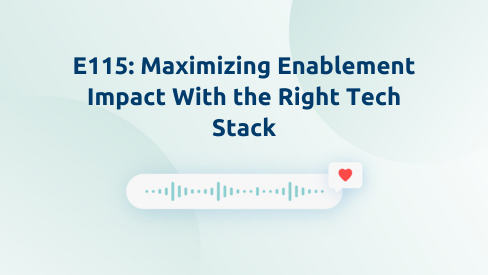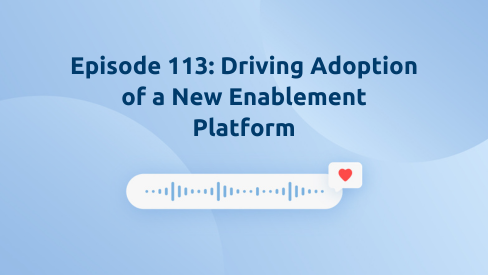According to Forbes, 71% of C-level executives believe sales productivity is critical to achieving growth. But unlocking this can often be easier said than done.
Shawnna Sumaoang: Hi and welcome to the Win Win Podcast. I’m your host, Shawnna Sumaoang. In the quest to drive sales productivity for your business, you’ve likely asked yourself: What does good look like? This month on the podcast, we’re helping you answer this question by exploring best practices on how you can deliver strategic enablement with Highspot.
Here to help us understand how to unlock sales productivity today is Jon Perera, chief marketing officer at Highspot. Thanks for joining Jon! I’d love for you to tell us about yourself, your background, and your role here at Highspot.
Jon Perera: Hi Shawnna. It’s a delight to be with you all. As you said, I’m the chief marketing officer here at Highspot. I also run our partner alliance team. I joined the company about four and a half years ago when we had less than a hundred employees, so it’s been really exciting to see the growth. Before Highspot I spent seven years at Adobe and about 18 years at Microsoft. I’m a native of Seattle, and happy to be here on the Win Win podcast with you.
SS: I am excited to have you here as well, Jon. Thank you so much for joining us. I’ll start with what seems like an easy question, but I’d love your perspective on this. What is sales productivity and why is it so important for companies to focus on that today?
JP: There are several definitions of sales productivity out there, and to keep it simple, I think it’s really just about how much revenue a company makes for every single sales rep. It is a really simple equation. When you’re in the boardroom, the discussion is also around what percentage of your reps are on quota. These are really critical questions because as it turns out, most sales reps aren’t spending most of their time selling. In fact, based on Gartner research, 72% of a rep’s time is spent not selling and not working with the customers.
If you consider a few things, for example, your company’s OPEX, sales, and marketing are perhaps often the highest percentage of your total OPEX, particularly in the B2B space. The board and the company and shareholders and stockholders and employees need to see the return on investment of that, and it’s more important now than ever.
Today’s economy is tough. Most salespeople have never sold through a down market like this. I’ve spoken with dozens of chief revenue officers who say, yeah, our salespeople haven’t sold in 2007 and 2008, so this is all very new and it’s also happening at a time when buying teams and the buying process has become much more complex. Sales productivity is probably topic number one in today’s boardroom.
SS: Which is why it is a critical topic when we think about what good looks like, and that is absolutely what we’re here to talk about today and how to leverage what good looks like to empower productivity, but to set the stage, Jon, I’m curious to hear from your perspective about the inverse of that. What does bad look like?
JP: I love this question and something that we’ve all suffered from at one point in our career. I’ll think about three things here, Shawnna. First of all, bad looks like the inability to execute a company’s strategic growth initiatives. If you look at a recent HBR article, it turns out that around 70% of all strategic initiatives fail. These are strategic initiatives to grow your business, and what often happens is that the boardroom, sales leadership, and marketing leadership may come up with exactly the right strategy to grow the business, retain your customer base, grow customer satisfaction, and drive cross-sell, but failure happens. You don’t have execution on the front line with your frontline salespeople and those strategic growth initiatives aren’t reinforced by sales managers.
I’ll give you a great example of this. Many companies have spent hundreds, if not millions of dollars on the implementation of a new sales methodology. Something like MEDDPICC and I’ve heard many CROs say, yeah, we’ve been working for 18 months on implementing our new sales methodology, but it’s actually not being carried through by sales managers and sales reps. You’ll also see marketing teams aren’t aligned with the new sales methodology. So that’s number one. It’s about the lack of execution of your strategic growth initiatives.
The second characteristic of what bad looks like is totally classic, and it’s when your sales and marketing teams aren’t aligned, they don’t have a single source of truth for the core message. They’re not aligned at a very detailed level on the goals. They don’t have a shared scorecard. They have two different scorecards, and we see this all of the time.
The last one I’ll mention is, we often see many companies have what I’ll call a patchwork approach to sales enablement. So what does that mean? They have dozens of different tools. They don’t have shared analytics on what’s working. They don’t have a single point of view around the process to land strategic initiatives, and they’re just trying to do enablement just in time with whatever the emergency fire drill of the day is. They don’t have the people, the process, or the tools really needed to roll things out smoothly. Those are three characteristics, I think, of what bad looks like.
SS: Now, again, to the topic at hand for today, what does good look like when it comes to driving sales productivity?
JP: I’ve spent probably the last three or four months speaking with dozens of chief revenue officers and CMOs on this quest to really understand what good looks like. Looking here within Highspot we have a fantastic enablement team and great process and learning from that. What good looks like I synthesize it down to three areas.
Number one, what’s in common for all these very high-performing companies is that they place a huge amount of focus and effort on their people and their culture. In particular, they’re talking about a culture of sales excellence, of sales rigor. They have a huge focus on diversity, equity, and inclusion. What good looks like are teams that are actively measuring what are the engagement scores of our frontline salespeople. There’s a deep investment and bet into the art and the craft of selling. When you hear what good looks like, number one is it’s about people and culture at the very core.
Number two, it’s about the process, and in particular, you hear a lot about having a system of operational rigor. What that means is that there’s no deviation, there’s no mystery around execution, and there is consistent behavior change and consistent execution of company strategy from the very top to the very front line. You see very strong alignment and a single source of truth between sales and marketing on the goals. There’s a deep inspection on a very regular basis around how we’re doing on funnel conversion at every single step. That notion of operational rigor is at the very core of the process of what good looks like.
The final area is technology. The interesting question in companies that are absolutely winning always has a system that equips, trains, and coaches their reps to be at their very best. I’ll give you an anecdote. I was recently speaking with the former chief revenue officer for DocuSign, and we were talking about what operational rigor looks like. He said, look, do you believe that your sales teams will be more productive if you effectively equip, train and coach them? Well, the answer to that has to absolutely be yes.
Then the next question is, well, whose job is that to equip, training coach? The answer really is the CRO or the head of sales in deep partnership with the head of sales enablement, but you can’t do it without a system, a technology platform, that allows you to coach on these behaviors that you want to see, that allows you to inspect, that allow you to have a single source of truth for each one of these areas. What good looks like are people, processes and technology coming together to create a system of operational rigor that helps sellers execute every time on time.
SS: Those are three fantastic areas of focus, and I think it’s also a wonderful segue into my next question, Jon, which is, what are some of the ways that Highspot can help teams be what good looks like?
JP: Great question. I would say two or three years ago, several of the key leaders within Highspot started to think very long and hard about this question. We were a technology company, first and foremost, deep bets on AI, deep bets on next-generation experiences for sellers, and we knew that that wasn’t enough. We started to look at companies within our portfolio of customers that were doing better than others, that were just really doing an amazing job at execution. It became clear that there were a number of patterns that emerged and we took all of that pattern matching and we created and launched something that we called the Strategic Enablement Framework.
Essentially what that says is based on where a company wants to go to execute your core programs, your key growth initiatives, and the business outcomes that you need to drive, you need a comprehensive system that thinks about how you equip, train, and coach and drive the behavior changes that you need at scale. We’ve taken that framework and we’ve made all of it available through the Highspot Spark Community, through our professional services teams, and through our Highspot University, as a system that companies can rely on that drives much more strategic enablement. I think the number one way in which we can help far above and beyond just our technology platform is through this methodology to drive more repeatable growth.
The second thing I’d mention is community. As a company, we’ve bet so deeply on the sales enablement community. We are deep believers in the change makers that these players have in your organization. In particular, we’ve created two noteworthy communities where people can connect, network, and share best practices. I’d call out the Highspot Spark Community, which is accessible, of course, right from within the product, and what some people don’t know is that we also built out the Sales Enablement PRO community that has events like the soiree that’s now almost 30,000 members strong. This bet on the community is a bet on discipline and the impact of strategic enablement. If we have a really thriving community, we think that we can help companies grow and have an impact the way that they want to.
The third area is around services and support. The excellence and the care that we have taken to make sure that every single customer is successful. We listen really carefully to our customers and how they want to drive growth, and recently we’ve actually operationalized a lot of those discussions into actual tools, real telemetry, where we can understand like, hey, if a company has a strategic growth initiative around, let’s say for example, cross-sell, well every single month, every quarter will be working with that customer on how are you doing, are you hitting the metrics that you want to? The analytics within Highspot will showcase the behavior change that you need to see if it is actually taking place so that we can help companies accelerate their growth. Those are three or four areas in which I think Highspot can really help on this front.
SS: I’d love to dive in a little bit more on that first one, which is around the Strategic Enablement Framework, because one of the things that I love about that methodology is it really helps to take the guesswork out of what good looks like and, as you’ve mentioned Jon, in times of economic uncertainty, I think clarity is key. Can you tell our audience about what it means to have strategic enablement?
JP: In our view, that’s a repeatable system that allows you to equip, train, and coach your sales reps in two specific areas. The first is what I call foundational programs, and the second is around the execution of these strategic initiatives that we’ve been discussing.
Let’s take a look at the first. It’s really interesting, even in today’s market where we’ve seen really painful degrees of layoffs in many different sectors, most companies will experience a churn of their sales force of around 30 to 35%. What that means is that on a 12-month basis, every sales company in the B2B space is probably hiring. 30 to 35% of their sales reps are brand new, and the more complex your product line, the longer the ramp time is. In some companies, it could be 8, 9, 10, or 11 months before a rep is off the ramp, so a foundational program within strategic enablement has to be onboarding. If you can shave one month, a month and a half off that ramp time, that’s massively impactful when it comes to sales productivity and impact on revenue.
It’s also about these strategic initiatives. At the core of that, I think there are a number of elements. One of them is coaching, which we’ve talked about a little bit, but as we talk to CROs around the world, one of the things that are becoming most apparent is that when you enable your field on a new project, a new initiative on a cross-sell approach, for example, one of the mistakes we see is that they’ll just go straight to the frontline and enable the reps.
What good looks like is actually enabling your sales managers maybe a month ahead of time, because you need those sales managers to coach the reps on what good looks like and how to really drive that strategic initiative all the way down to the front line. It’s about having the right message and making sure that at every point of the buyer’s journey, every rep is equipped with the right message at the right time of the sales cycle to help move that deal forward.
All of this, I think, really requires a system of strategic enablement where you’re looking left to right around how we equip our reps, how we train them effectively and onboard them faster than before, and enable our sales managers to be world-class coaches. If you pull all those together, you can really have a system that helps companies land both foundational programs, which are absolutely core to running your business, and maybe more importantly, those things that are growth drivers even in this down market.
SS: I would love to understand, especially given your role at Highspot as CMO, what role does marketing play in driving sales productivity and really helping to empower what good looks like?
JP: First of all, I’d say a lot of it is about what’s the mission of marketing. In my view, it’s about helping sellers win deals. We live and exist to serve sales and the more that we really deeply embrace that mindset, the better job that we can do in terms of helping drive seller productivity. Now, by the way, it goes beyond that. It’s about helping customers be successful. It’s about driving category thought leadership. It’s about driving customer satisfaction, but specific to sales productivity, it’s taking that mindset that we’re here to serve.
Where does that start? I think it starts with seller empathy. Do the marketers in the organization spend a lot of time working with sellers on deals, listening in on calls, attending meetings, really being investigative and curious about what are the hardest questions that customers are asking, and having really deep seller empathy, knowing what it’s like and how hard these questions are that our reps are getting? It’s a mindset shift that is so critical to driving sales productivity. Number one on my list is that mission and sense of empathy and knowing what it’s like.
Number two is that it is the role of marketing to set sales up for success when it comes to competitive insights. Really aggregating and understanding what are competitive trends, like where’s your competitor trying to upend you? How do you really equip, train and coach every single seller at your company around the battle card and the sales play on the competitive front? It’s marketing’s job to be the subject matter expert and to help the company understand how we win competitively.
Hand in hand with that, it’s about the ICP, the ideal customer profile, and the buyer insights. What are the hardest pain points that customers have and how can we really craft our story and our market to air covers every single stage of the funnel from the top of the funnel, all the way through to when deals are in the negotiation stage that we’re providing the tools, the resources, the case studies, the references, the business case needed to really address those buyer insights that we’re aggregating.
The next one on the list is around building a compelling message, and I think the old way of having a really strong message was marketers would go do a bunch of customer research, they’d understand what the message is, and they’d roll it out to the field, and that worked for a long time, but I think today what good looks like is a much more collaborative approach to the development of the message.
I’ll give you an anecdote about something we did here at Highspot that I just really think is effective. Around twice a year we pull together sales, marketing, and enablement. We pull people that are on the front line of all these roles, people that are managers, and people that are vice presidents of the company for a series of workshops and we build the core message together. The reason that we do that is that we keep it real. We’re grounding ourselves on what are the really hard questions, what’s really working, and let’s do this together so you create shared buy-in because we created the message together, which then means there’s a much higher likelihood that it’s consistent across the entire company.
Something I mentioned earlier, it’s about having an aligned sales and marketing scorecard. Marketing’s job is to really understand those sales metrics and KPIs and understand exactly every step of the journey. Every MQL, every pipeline generated, every marketing attribution, touchpoint, how is it helping move deals forward? I think the last thing I would mention is that marketing’s job is to really understand the analytics of the content, the campaigns, the programs, and the sales plays, and understand what works so that we can scale it.
Platforms like Highspot allow access to those analytics that allow us to fine-tune our job and make it even better so we’re providing better content, better campaigns, and better approaches to drive prospects through the funnel. Those are some of the things that I think about in terms of the role of marketing to really drive sales productivity and empower what good looks like, especially during these times.
SS: Jon, thank you so much for sharing your CMO perspective on what good looks like. To close, what advice would you give other executive leaders who are looking to unlock sales productivity within their organizations?
JP: I’m not sure I’d call this advice so much as maybe what we’re all learning from each other. As I mentioned earlier, I’ve been spending a lot of time with CROs and CMOs at high-growth B2B companies in the last few months just asking the question like, what does good look like? If I were to aggregate all of that, what I’m learning, and maybe the advice from all of the cohort, what’s very common is that right now what’s needed is a system of operational rigor in the selling process, and that’s about the elimination of guesswork. It’s about eliminating just-in-time enablement, and it’s about having a very strong structured approach to driving repeatable behavior change across your field.
What we’re hearing is that it comes down to these three areas that I have mentioned before, investing in your people is job number one. It has never been more important. It’s that very first experience they have when they’re interviewing. It’s about the onboarding experience and the excellence of the program you have onboarding. It’s about the culture that’s created by sales and marketing leaders. Having a culture of sales excellence and execution rewarding helps people be experts at their craft. Really deeply embed diversity, equity, inclusion, and belonging through their approach, and don’t forget the importance of coaching. Most frontline sales managers were great sales reps, but they were never trained on how to be great coaches.
I think learning and advice number one is that it all starts and very obviously, with people and it has those dimensions. Number two, it’s about the process for operational rigor and programs like the Highspot Strategic Enablement Framework that systematically looks at how we equip, how we train, how we coach, and how we get the analytics on what’s working. How can we actually train, track and measure that we’re driving the behavior changes that we need to see in our field? That is absolutely critical.
Then finally, it’s about making sure your sellers and your enablement team, and your sales process have the right tech stack in place. Frankly, most companies have too many sales tools. I’ve spoken with a number of people who say, yeah, no, we have 10, 12, 16 different sales tools. If you can consolidate down to the critical few that allow you to have one system for execution, you’re creating a stronger bias for excellence and a stronger system for operational rigor. That’s what we’re learning, that’s what we’re really excited about, and that’s everything around what good looks like. We’re putting a lot of our learning and resources into the Highspot Spark Community to share with you.
SS: Absolutely. Jon, thank you so much for joining us today.
JP: It was a delight.
SS: To our audience, thank you for listening to this episode of the Win Win podcast. Be sure to tune in next time for more insights on how you can go beyond what good looks like with Highspot.



